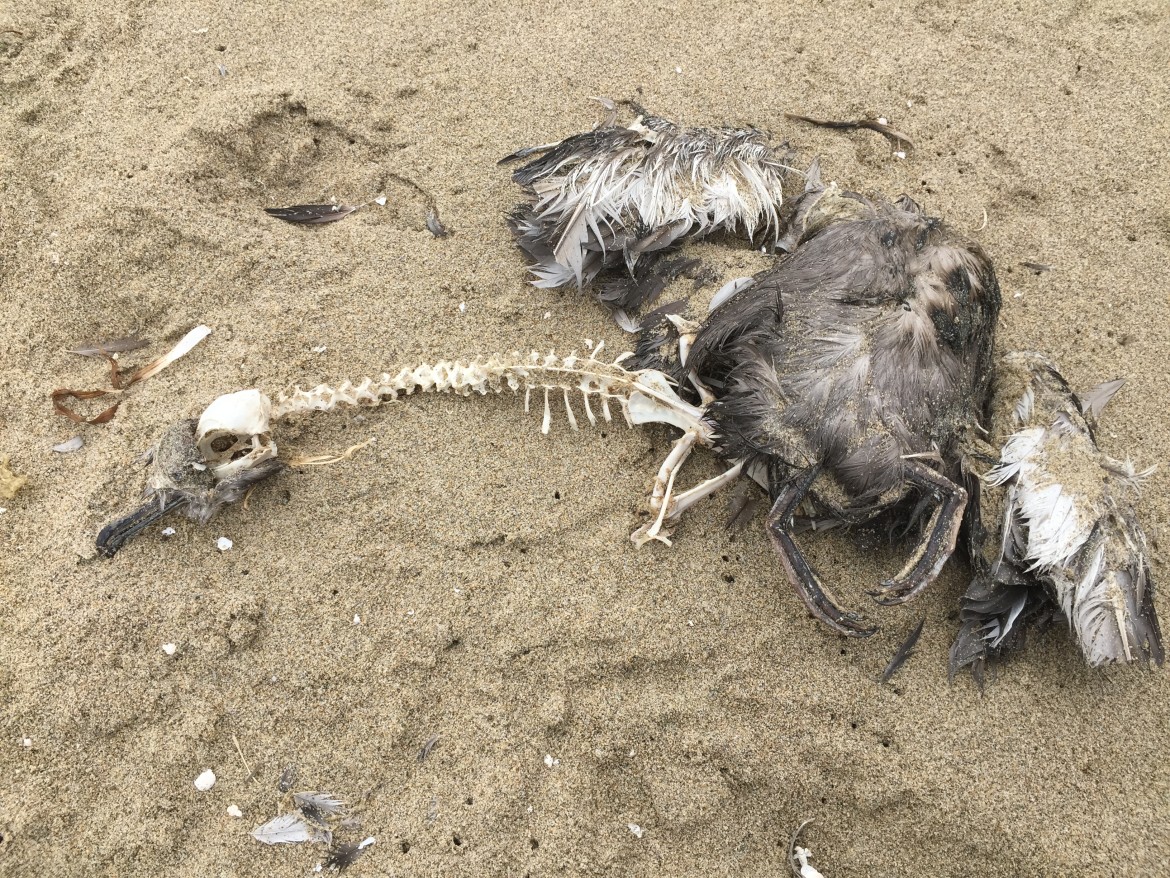By Raven Gray / Deep Green Resistance
Dec 21st, 2014. I walk to Kehoe beach with my son. A winter storm is raging from the northwest, blurring the boundary of sky and sea. We have the place to ourselves. The tide is out, but the wind carries the waves up to the high tide line. Trash is everywhere; candy wrappings, drinking straws, polystyrene balls, plastic bottle tops, bullet cases. We start to pick it up, when I realize that there are hundreds of dead birds buried in the sand, tangled up in the piles of kelp. Once I see them, I cannot look away, their bodies scattered as far as the eye can see. I start counting, but stop after a while. All of them are Cassin’s Auklets.
April 24th, 2015. I drive to Limantour Estero on a bird watching trip, with five local birders. My heart bursts to see the burnt and broken landscape, and I call out: “Look! Look how the Bishop Pines are dying! So many have died in the past year!” The conversation falls silent. The guide clears his throat, looks back at me and says he hadn’t really noticed, it all looks fine to him. He says he’s more interested in the birds. The woman next to me turns and says: “Maybe it’s their time to go. Everything dies, you know.”
August 24th, 2015. I return to Kehoe Beach with my son. A strong northwesterly carries the stench of death into the dunes, attacking our nostrils long before we reach the sea. It’s unwelcoming but I want to be a witness, so we walk on. The tide is low, and as we reach the high tide line, I can see that once again, countless dead birds are buried in the sand. The wrack zone is composed entirely of white feathers stretching in both directions, as far as the eye can see. I start counting, but stop after a while. All of them are Common Murres.
September 6th, 2015. I take my son to Drake’s Beach Sand Sculpture Contest. It’s hot, in the 90s, and there are over three thousand people there. I notice a large plastic bucket in the crowd. Some people walk past and look into it, then move on. Curious, I walk over. Inside, a cormorant is lying prostrate, flapping one wing. It is being baked alive. I pick her up and wrap her in my shirt. I whisper: “It’s OK. I’ve got you now.”
I look around for a park ranger to help. The first one shrugs: “Maybe it’s their time to go. Everything dies, you know.” The second one says: “It’s illegal to touch that bird.” “Go ahead,” I say. “Arrest me.” The third one says: “Yes, the sea birds are dying. It’s part of a natural die-off. I’m sorry, but the Park’s policy is to let nature take it’s course”. I tell her that there is nothing ‘natural’ about human induced climate disruption. I tell her that acidification of the oceans, warming seas, toxic algal blooms, Fukushima radiation, plastic pollution, and collapsing marine ecosystems are all man-made disasters. I tell her that the bird in my arms is intelligent, sentient, and that she deserves to live. That she has rights too, and it is our responsibility to protect those rights. At this moment, the bird raises her head and a bright ray of light shines out through her one aquamarine eye. She looks straight at me and promptly dies in my arms. I take her to a quiet place with my son, and we sing the ancestor song. We pray our tears will guide her home. On the way back we witness another cormorant curled up on the beach. We watch in silence as she dies too.
September 29th, 2015. It’s my birthday, and I walk to Limantour beach. On the way, I notice how many more Bishop Pines have died in the past few months. The landscape is beginning to look like Mars. When I get close to the beach, I’m overcome – again – with the stench of death. I look for dead birds and find them. Feathers and bones scattered in the shifting sands. I don’t bother to count them. The ocean water is pea-green tobacco soup. It smells acrid, like sulphur. I realize this must be the “blob” – the largest toxic algal bloom ever recorded, stretching 40 miles wide, 650 feet deep, running all the way from central California up to Alaska. I wonder how many lives it has taken, how many more it will take, and whether it will be here next year, and the year after, and the year after that, until eventually the whole ocean becomes one giant toxic blob bloom, devoid of all life?
The mass die-offs happening in the Pacific Ocean are not confined to birds. Sea lions, seals, dolphins, whales, anchovies, crabs, sea otters – all are dying in unprecedented numbers. They are starving to death. They are being poisoned. They are being killed. We are in the midst of the Sixth Great Extinction, and we are the cause.
Who will stand and bear witness? Who will count the dead? Do you have the courage to turn your face towards the pain, towards the dark truth of what we are doing to this earth? Or will you turn your face away as the world burns and dies around you?


Trackbacks/Pingbacks